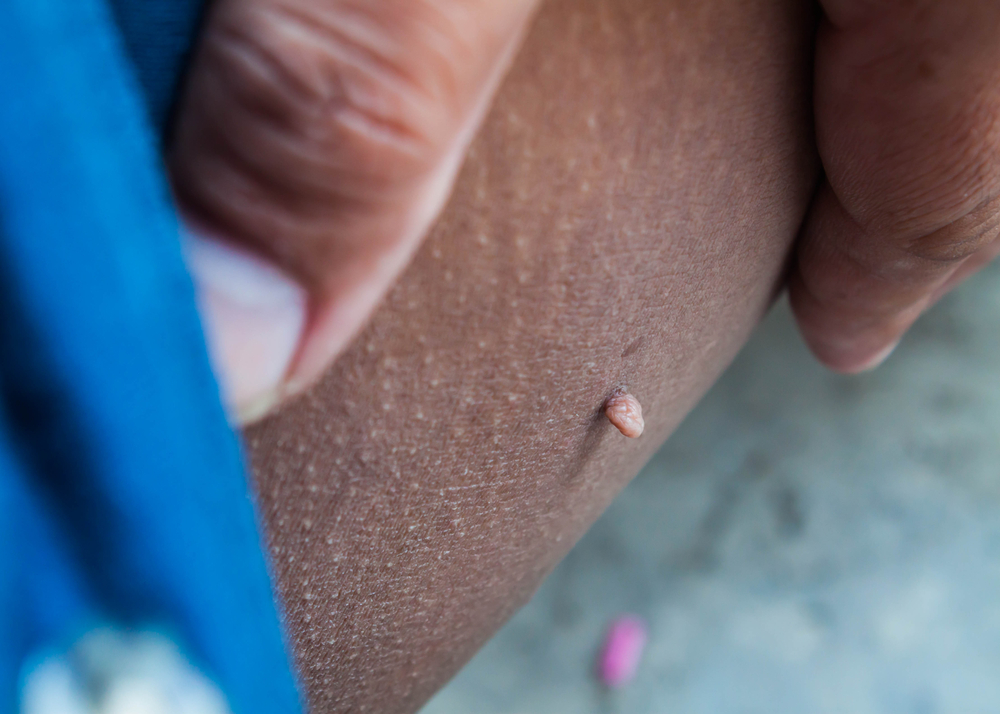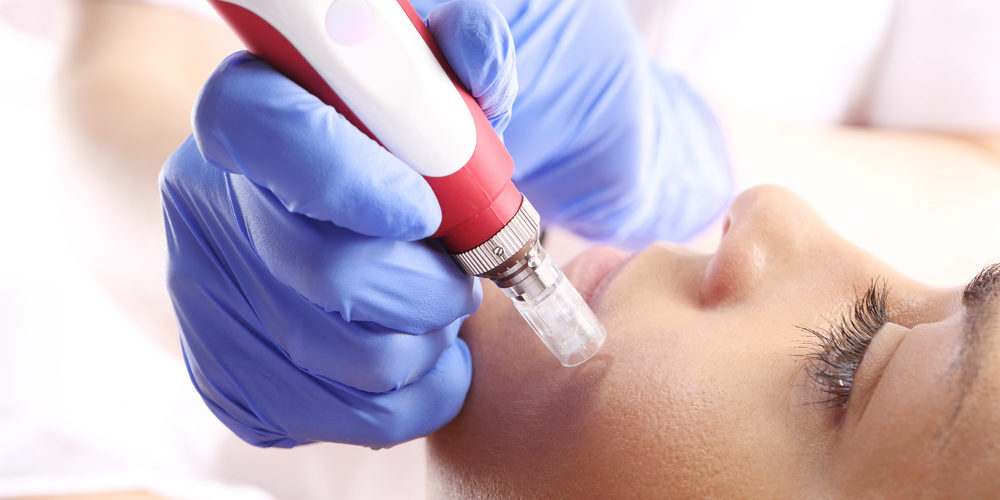- A skin tag is an extremely common skin growth affecting 25% of adults.
- Skin tags are not dangerous.
- Skin tags are easily removed by your doctor or dermatologist.
About 25% of us will get a skin tag at some point in our lives.
Skin tags are rare when we’re very young but become more common later in life. Some of us have lots of them while others just get one or two over the course of their entire lives.
What Are Skin Tags?
The medical term for a skin tag is an “acrochordon”. They are small benign tumors which usually appear where skin forms creases. These tiny sprouts of skin are typically connected to the surrounding skin by a thin stalk.
Skin tags are common anywhere that our skin folds over and touches other skin — such as the underside of breasts, armpits, around the groin and on the eyelids. Skin tags may also appear on the face, neck, back, and other areas — although they’re less common in areas without folds.
Are skin tags dangerous?
No. Skin tags are not dangerous. They are benign skin growths and extremely common. Most people with skin tags have them removed, but only for aesthetic reasons. There is no medical necessity to remove them. Nor is there any reason to remove benign growths as quickly as possible. You can have them removed whenever you want.
Some medical conditions like diabetes and obesity may make skin tags more likely to appear. In these cases it’s not the skin tags themselves that are dangerous, but rather the underlying medical conditions creating them which should not be ignored.
Most importantly, some conditions that might look like skin tags are actually more serious. If your skin growths are rapidly increasing in size, have jagged edges, or begin to change color, visit your physician right away in order to rule out any potentially serious condition like skin cancer.
What causes skin tags?
There is no one single cause of skin tags. Scientists attribute them to several factors:
- Skin folds — We know that skin tags seem to develop in areas where the skin folds, and where skin rubs against skin. Scientists believe that this may be caused by friction and foreign substances becoming trapped in the folds of skin. Skin tags may also develop where clothing presses or rubs against skin.
- Age — Older people tend to get more skin tags than younger people. This may be due to the fact that our skin develops more folds and wrinkles as we age.
- Obesity — Obese people tend to get more skin tags than slim people. This also correlates with an increased amount of skin folding due to excessive fat.
- Pregnancy — Women who are pregnant have a higher chance of getting skin tags. While this may be partially due to weight gain during pregnancy, the increase in skin tags is thought to be related to the natural changes in hormone levels pregnant women experience.
- Steroid use — Steroid use is another element correlated with skin tags. This too may be due to shifts in hormone levels, but could also be the result of an increase in skin collagen.
- Human Papillomavirus (HPV) — Some studies show a correlation between HPV and skin tags. In one study, the virus was present in nearly 50% of the subjects’ skin tags.
- Diabetes — There’s some evidence that people with diabetes are more likely to develop skin tags. The reasons for this are not fully understood but it’s thought to be related to excess levels of the hormone insulin.
Do skin tags itch? Do they ever hurt?
Skin tags don’t usually cause pain but when subject to excessive friction can become mildly irritating or itchy.
Skin tags can also cause itching when they are healing. If you recently cut, scraped or removed a skin tag, any remaining extra skin may cause mild itching.
If your skin tag is causing you prolonged discomfort, you should visit a dermatologist to make sure it isn’t something potentially more serious. Sores from certain sexually transmitted diseases and other skin conditions can look similar to skin tags.
Do skin tags grow bigger?
Typically skin tags will reach a final size and stop growing. If your skin tag continues to grow and/or significantly changes shape or color, be sure to have it examined by a doctor in order to rule out more serious conditions.
Do skin tags spread? Are they contagious?
Skin tags are not contagious, nor do they spread.
That being said, you could get more than one skin tag in the same location. For example, it’s not uncommon for those prone to skin tags on the eyelids or under the breasts to get multiple skin tags in these locations. The presence of one skin tag, however, does not lead to or cause a second or third tag to appear.
Do skin tags go away by themselves?
Skin tags don’t typically dissipate on their own, but it can happen. A skin tag may become twisted due to repeated friction and movement. When this occurs its blood supply becomes restricted and the skin tag may fall off.
Skin tags that occur during pregnancy are thought to be due to natural hormonal changes that occur in the body. After childbirth hormonal levels may return to their normal state and the skin tag may disappear.
Who removes skin tags?
Any family doctor or dermatologist can remove skin tags. While it’s possible to remove smaller skin tags by yourself (see the Home Remedies question below), home removal of larger skin tags carries the risk of excessive bleeding or infection.
How are skin tags removed?
Doctors have multiple options for removing skin tags. These include cauterizing them with an electric current, freezing the skin tag with liquid nitrogen cryotherapy, or surgically removing them.
The procedure to remove a skin tag is extremely fast and painless. If painkillers are given at all, a local anesthetic — like a topical anesthetic cream or lidocaine injection — is used. Very small skin tags often require no anesthetic.
1. Burning it off
Many dermatologists use cauterization to burn off skin tags. The cauterization process employs an electrical current to burn the thin stalk that connects the tag to the skin. Because the electric current burns and seals the skin, there is no bleeding.
2. Freezing it
By spraying or carefully applying ultra-cold liquid nitrogen, dermatologists can destroy the cells that make up the skin tag. After freezing, the skin tag will resemble a small blister and fall off after a few days.
3. Cutting it off
Most dermatologists will remove a skin tag by cutting the thin stalk that connects it to the rest of the skin with a surgical blade or scissors. This is an extremely fast procedure requiring only local anesthesia. It does come, however, with a very slight risk of scarring, depending on the size of the skin tag.
Are there any home remedies for skin tags?
Typically home removal only works with very small skin tags connected by a very thin stalk.
1. String or dental floss
The simplest home remedy is to tie a very small piece of thread or dental floss tightly around the base of the skin tag. Once the blood supply to the skin tag is cut it should fall off within a few days.
2. Salicylic acid
If it’s small enough you can apply a salicylic acid-based wart remover to a skin tag. The salicylic acid can be applied with a cotton swab or Q-tip. After several days of treatments the skin tag should fall off by itself. Salicylic acid does not work well with large skin tags.
3. Apple cider vinegar
You may find many home remedies recommending apple cider vinegar to remove skin tags. In some cases, the vinegar is mixed with a few drops of tea tree oil. This typically only works on extremely small skin tags, when at all.
Can I pull a skin tag off?
You should never attempt to pick at a skin tag. Picking at it will likely just cause irritation, and if done repeatedly it may start to bleed. Nor should you attempt to pull a skin tag off. This may cause excessive skin tearing and/or bleeding which could lead to infection.









